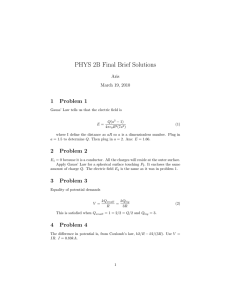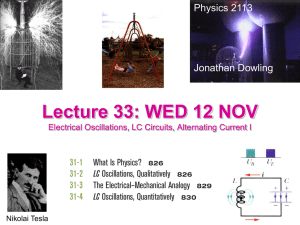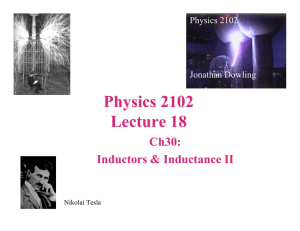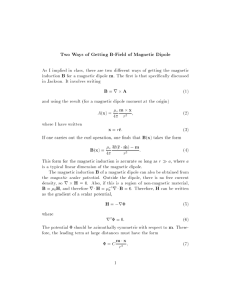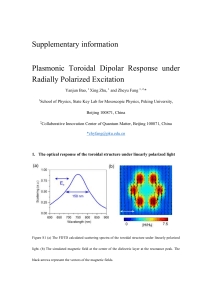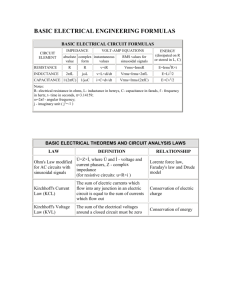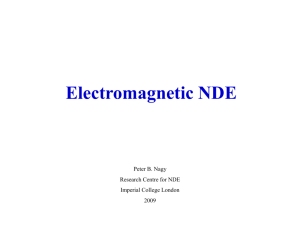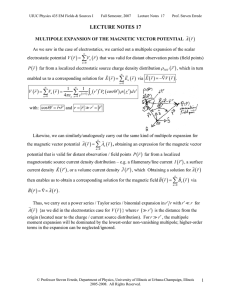Electrostatics Electrostatic Energy
advertisement
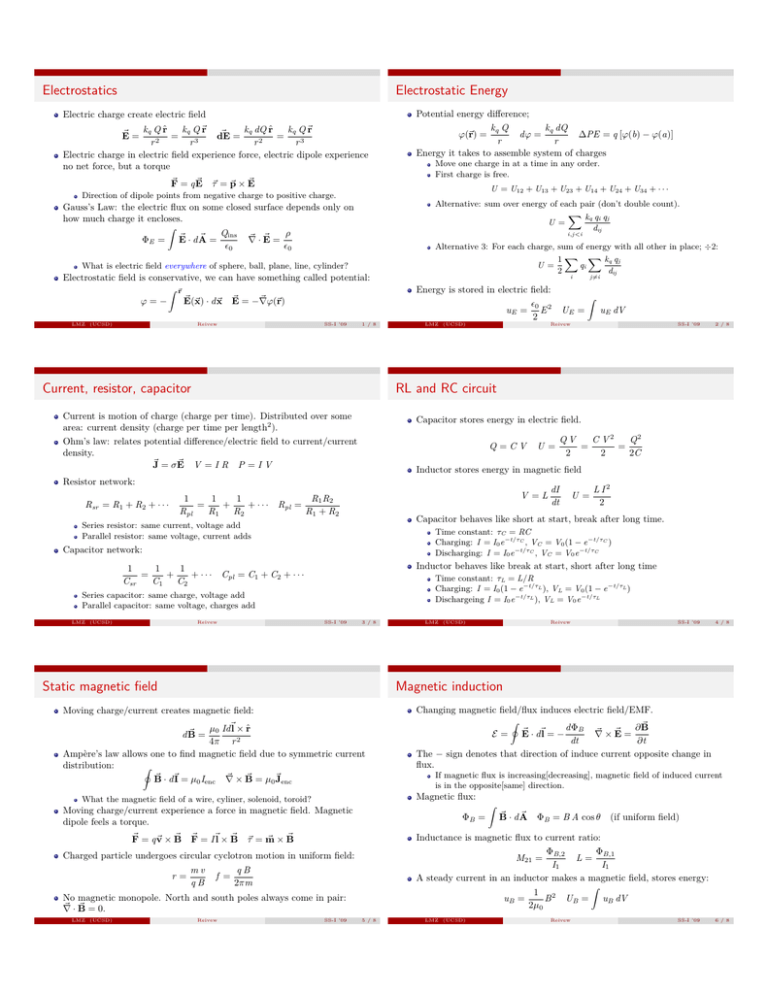
Electrostatics Electrostatic Energy Electric charge create electric field ~ = kq Q r̂ = kq Q ~r dE ~ = kq dQ r̂ = kq Q ~r E r2 r3 r2 r3 Electric charge in electric field experience force, electric dipole experience no net force, but a torque ~ = qE ~ ~τ = ~p × E ~ F Potential energy difference; kq Q kq dQ ϕ(~r) = dϕ = ∆PE = q [ϕ(b) − ϕ(a)] r r Energy it takes to assemble system of charges Move one charge in at a time in any order. First charge is free. U = U12 + U13 + U23 + U14 + U24 + U34 + · · · Direction of dipole points from negative charge to positive charge. Alternative: sum over energy of each pair (don’t double count). Gauss’s Law: the electric flux on some closed surface depends only on how much charge it encloses. Z ~ · dA ~ = Qins ∇ ~ = ρ ~ ·E ΦE = E 0 0 U = What is electric field everywhere of sphere, ball, plane, line, cylinder? Reivew SS-I ’09 1 / 8 Current, resistor, capacitor Alternative 3: For each charge, sum of energy with all other in place; ÷2: 1 X X kq qj U = qi 2 dij i Energy is stored in electric field: 0 uE = E 2 2 LMZ (UCSD) uE dV Reivew Q=CV U = SS-I ’09 2 / 8 1 1 1 = + + ··· Rpl R1 R2 Rpl V =L R1 R2 = R1 + R2 U = SS-I ’09 4 / 8 L I2 2 Time constant: τC = RC Charging: I = I0 e −t/τC , VC = V0 (1 − e −t/τC ) Discharging: I = I0 e −t/τC , VC = V0 e −t/τC Capacitor network: Inductor behaves like break at start, short after long time Cpl = C1 + C2 + · · · Time constant: τL = L/R Charging: I = I0 (1 − e −t/τL ), VL = V0 (1 − e −t/τL ) Dischargeing I = I0 e −t/τL ), VL = V0 e −t/τL Series capacitor: same charge, voltage add Parallel capacitor: same voltage, charges add Reivew dI dt Capacitor behaves like short at start, break after long time. Series resistor: same current, voltage add Parallel resistor: same voltage, current adds 1 1 1 = + + ··· Csr C1 C2 QV C V2 Q2 = = 2 2 2C Inductor stores energy in magnetic field Resistor network: SS-I ’09 3 / 8 Static magnetic field LMZ (UCSD) Reivew Magnetic induction Moving charge/current creates magnetic field: ~ ~ = µ0 Id l × r̂ dB 4π r 2 Ampère’s law allows one to find magnetic field due to symmetric current distribution: I ~ · d~I = µ0 Ienc ∇ ~ = µ0~Jenc ~ ×B B Z f = qB 2πm No magnetic monopole. North and south poles always come in pair: ~ = 0. ~ ·B ∇ Reivew SS-I ’09 ~ · dA ~ ΦB = B A cos θ B (if uniform field) Inductance is magnetic flux to current ratio: ΦB,2 ΦB,1 M21 = L= I1 I1 A steady current in an inductor makes a magnetic field, stores energy: Z 1 2 uB = B UB = uB dV 2µ0 Charged particle undergoes circular cyclotron motion in uniform field: mv qB If magnetic flux is increasing[decreasing], magnetic field of induced current is in the opposite[same] direction. ΦB = ~ = q~v × B ~ F ~ = I~l × B ~ ~τ = m ~ ~ ×B F r= Changing magnetic field/flux induces electric field/EMF. I ~ ~ · d~l = − dΦB ∇ ~ = ∂B ~ ×E E= E dt ∂t The − sign denotes that direction of induce current opposite change in flux. Magnetic flux: What the magnetic field of a wire, cyliner, solenoid, toroid? Moving charge/current experience a force in magnetic field. Magnetic dipole feels a torque. LMZ (UCSD) Z UE = Capacitor stores energy in electric field. Ohm’s law: relates potential difference/electric field to current/current density. ~J = σ E ~ V =IR P=IV LMZ (UCSD) j6=i RL and RC circuit Current is motion of charge (charge per time). Distributed over some area: current density (charge per time per length2 ). Rsr = R1 + R2 + · · · dij i,j<i Electrostatic field is conservative, we can have something called potential: Z ~r ~ x) · d~x E ~ = −∇ϕ(~ ~ r) ϕ=− E(~ LMZ (UCSD) X k q qi qj 5 / 8 LMZ (UCSD) Reivew SS-I ’09 6 / 8 AC Circuit Source geometry and field Impedance is complex: ZR = R ZC = 1 iωC Geometry ZL = iωL Dipole Can be treated as resistance in the following ways: Allows use of resistance addition formulae for series and parallel connection: Zserie = Z1 + Z2 + · · · Point, Sphere 1 1 1 = + +· Zparallel Z1 Z2 Line, Cylindrical (outside) The magnitude of the impedance related peak voltage and peak current like Ohm’s law: |Z | = p (Re Z )2 + (Im Z )2 Plane, sheet, slab (outside) Vpeak = |Z |Ipeak The phase of the impedance is how much in phase voltage is ahead of current. φZ = arctan LMZ (UCSD) Im Z Re Z V (t) = Vpeak sin(ωt) I (t) = Ipeak sin(ωt − φZ ) 1 E-field 2 B-field Reivew SS-I ’09 7 / 8 Electric field qd 20 (x 2 + d 2 )3/2 q 4π0 r 2 λ 2π0 r σ 20 Mangetic field 1 µ0 (I a 2 ) 2(z 2 + a 2 )3/2 2 D.N.E. µ0 I 2πr µ0 Js 2 Inside shell ∼0 ∼0 Inside solid ∼r ∼r along the x-axis of a dipole consists of charge ±q posited at y = ±d/2. along the center axis, distance z away from center LMZ (UCSD) Reivew SS-I ’09 8 / 8
